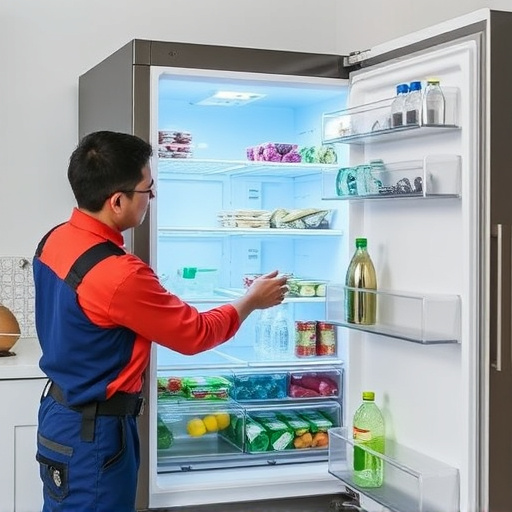Ice makers, while convenient, require regular maintenance and prompt attention to issues like water filling problems, slow ice production, or clogged accumulators to ensure optimal refrigerator function. Self-installation of new ice makers is cost-effective, but proper tools, model-specific parts, and thorough verification are essential for successful repairs. Before calling a professional Refrigerator Repair service, perform basic troubleshooting for common ice maker issues, keep the appliance clean and well-maintained, monitor energy usage, and recognize when complex problems necessitate expert intervention to avoid costly and inconvenient breakdowns.
Ice makers are a convenient addition to your kitchen, but they can also pose problems that require repair or even replacement. Understanding common issues and their causes is the first step towards efficient troubleshooting. This guide covers everything from installation to maintenance, ensuring optimal ice-making performance. Learn about essential tools, parts, and techniques for DIY repairs. Know when professional refrigerator repair services are needed, saving you time and hassle in the long run.
- Understanding Common Ice Maker Issues and Their Causes
- Step-by-Step Guide to Ice Maker Installation
- Tools and Parts Required for Repair
- Troubleshooting Tips for Common Problems
- Maintaining Your Ice Maker for Optimal Performance
- When to Seek Professional Assistance for Refrigerator Repair
Understanding Common Ice Maker Issues and Their Causes
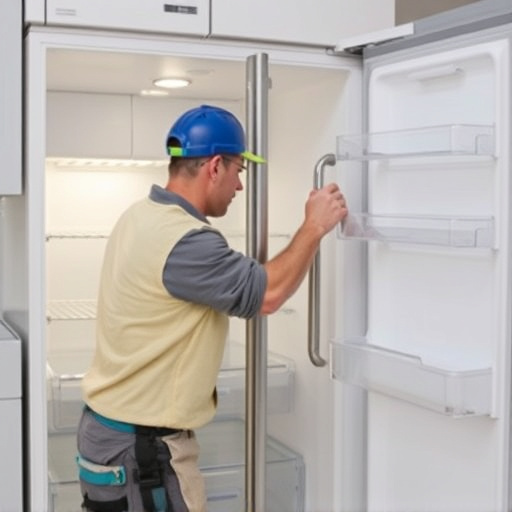
Ice makers are a convenient feature in many homes, but like any appliance, they can develop issues over time. Understanding common problems and their root causes is the first step toward effective troubleshooting and maintenance. One of the most frequent issues is water not filling the ice tray, which could be due to a faulty water valve or an obstruction in the water line. Another common problem is the ice maker not making ice fast enough or at all; this might be caused by a malfunctioning temperature sensor or a broken fan motor responsible for cooling the water.
Refrigerator repair often involves these ice makers, and it’s essential to address issues promptly to maintain optimal fridge performance. Over time, ice accumulators can become clogged with dirt or frozen debris, impacting water flow and temperature control. Regular cleaning and maintenance are key to preventing these issues. Additionally, electrical problems, such as a blown fuse or faulty wiring, can also hinder the ice maker’s function, underscoring the importance of a comprehensive approach to appliance upkeep.
Step-by-Step Guide to Ice Maker Installation
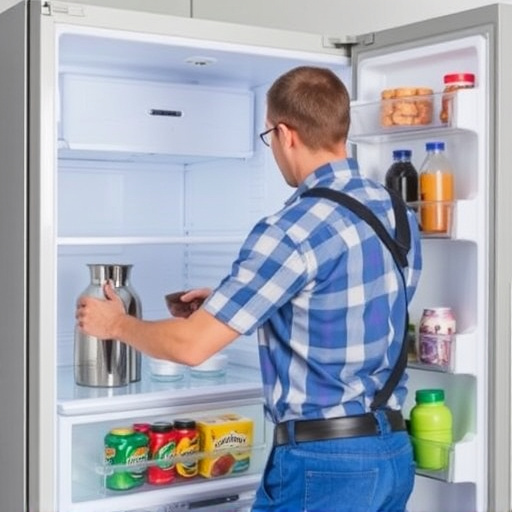
Installing an ice maker is a relatively straightforward process, and with the right tools and a few simple steps, you can do it yourself, saving time and money on Refrigerator Repair. First, locate the water supply lines behind or beneath your freezer. Turn off the water valves and use a wrench to detach the existing ice maker’s water connections. Once the old ice maker is removed, measure the space available for the new one, ensuring it fits securely. Attach the new ice maker’s water lines to the valves, then plug in any electrical connections following the manufacturer’s instructions. Before turning on the water, double-check all connections for leaks and tighten as needed. With proper installation, your new ice maker should be ready to chill and make fresh ice for years to come.
Tools and Parts Required for Repair
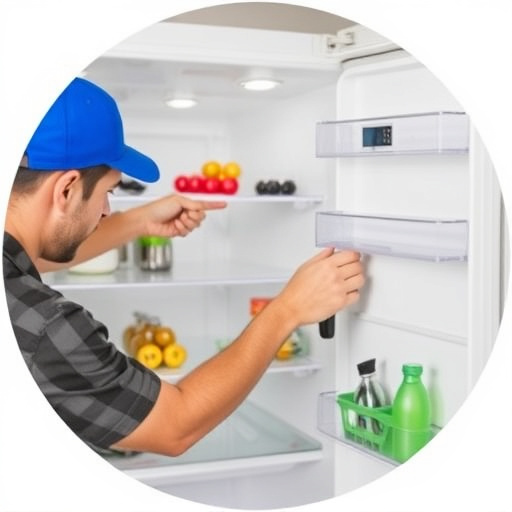
When tackling a refrigerator repair, especially for an ice maker, there are several tools and parts you’ll need to have on hand to ensure a successful fix. The standard toolkit should include a set of screwdrivers (both flathead and Phillips), a new O-ring or seal (often the culprit behind ice buildup or water leakage), a replacement ice maker kit (which may contain various components like a new ice mold, motor, or control board), and a solution for cleaning any built-up frost or ice.
For more complex issues, you might require specialized tools like a thermal imaging camera to identify frozen pipes or a multimeter to test electrical connections. Always double-check your refrigerator’s model number to source the correct replacement parts, ensuring a seamless and effective refrigerator repair.
Troubleshooting Tips for Common Problems
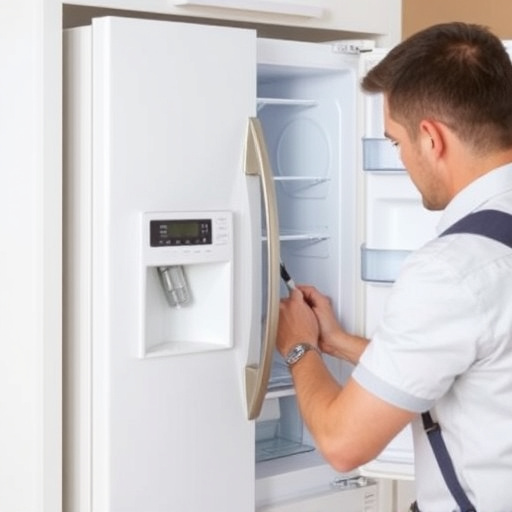
When it comes to troubleshooting common ice maker problems, there are a few simple steps to take before considering a refrigerator repair service. First, check the power supply to ensure the ice maker is receiving electricity. A tripped circuit breaker or loose wire can easily disrupt its operation. Next, inspect the water supply line for any leaks or blockages; a faulty connection or clogged filter can hinder the flow of water necessary for ice formation.
Additionally, verify that the ice maker’s settings are correct, as many models have adjustable options for ice production and temperature control. If the issue persists, consider common problems like a frozen evaporator coil, which can be addressed by unplugging the unit and allowing it to thaw. Regular maintenance, such as cleaning the ice bin and replacing filters, can also prevent future malfunctions, keeping your ice maker running smoothly.
Maintaining Your Ice Maker for Optimal Performance

Maintaining your ice maker is essential for ensuring optimal performance and extending its lifespan, especially if you rely on it as a convenient feature in your kitchen. Regular cleaning is key; consider scheduling periodic deep cleans to remove any buildup of salt or minerals. This simple step can prevent clogs and ensure consistent ice production. Additionally, checking the water supply lines for leaks or blockages is vital. Repairs, such as fixing a leaky valve or replacing worn-out parts, should not be postponed, as they can lead to more significant issues and potentially costlier refrigerator repair.
Proper maintenance also involves monitoring energy consumption. If you notice a sudden spike in electricity usage, it might indicate an underlying problem that requires attention. Keeping your ice maker well-maintained will not only save you from frequent trips to the store for ice but also contribute to overall energy efficiency.
When to Seek Professional Assistance for Refrigerator Repair
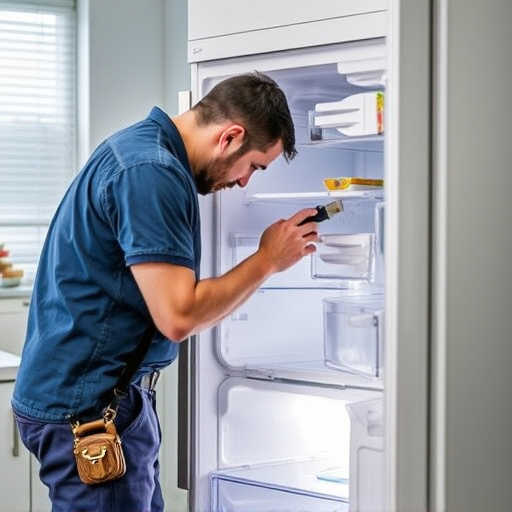
When it comes to refrigerator repair, knowing when to seek professional assistance is crucial for maintaining your convenience and ensuring your fridge remains in top working condition. While minor issues like a frozen water line or a faulty ice maker can often be addressed through basic troubleshooting and DIY repairs, more complex problems require the expertise of a trained technician.
Ice makers, for instance, can break down due to various reasons, such as malfunctioning sensors, motor failures, or blocked drains. If your ice maker is not producing ice, making unusual noises, or freezing up frequently, it might be time to call in a professional. Experienced repair technicians have the tools and knowledge to diagnose the issue accurately and provide effective solutions, ultimately saving you time, money, and the hassle of dealing with an inefficient or broken-down refrigerator.
Whether you’re dealing with a broken ice maker or considering a new installation, understanding the process and common issues can save you time and money. This guide has equipped you with the knowledge to navigate refrigerator repair, from identifying issues like a frozen cube tray to successfully installing or fixing your ice maker. Remember, regular maintenance and prompt troubleshooting are key to keeping your kitchen running smoothly. For complex problems persisting despite DIY efforts, don’t hesitate to consult a professional for reliable refrigerator repair services.
